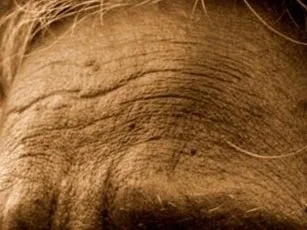This site was produced by Maïa Ponsonnet, Linguist at The University of Western Australia, in concertation with […]
The forehead
Emotional expressions with the forehead only occur in a relatively small proportion of Australian Indigenous languages, albeit with a large number of expressions in some of them, like in Yolngu Matha (Arnhem Land). Forehead expressions seem infrequent in Central Australia. In a number of languages, words for ‘forehead’ also mean ‘face’, yet perhaps surprisingly, words for ‘forehead’ do not often appear to mean ‘head’ at the same time. However, there are resemblances between forehead and head expressions, as may be expected given the forehead is a prominent part of the head. There are also resemblances with the nose.
Negative social attitudes
Like head and nose expressions, forehead expressions map predominantly onto social emotions and attitudes – and mostly negative ones at that. The only mildly positive expressions are also social attitudes, for instance compliance and patience. Forehead expressions typically denote stubbornness, selfishness, lack of consideration, anger, as well as being socially distant. Shame is absent among forehead expressions, contrasting with head expressions where it is well represented. We also find a slightly higher proportion of non-social emotions among forehead expressions as compared to those with the head, including shock, sadness or jealousy.
Movement
Figuratively, forehead expressions combine features observed in head expressions, nose expressions, and to a lesser extent, eye expressions. Like nose expressions, those with the forehead sometimes allude to movements and postures of the head or face. In Djinang (Yolngu, Arnhem Land), for instance, bumir ṭinydjigi, literally ‘forehead turn head away, ignore’ means ‘be jealous’, an emotion associated with dislike or disdain, which may indeed bring one to physically turn away.
Extensions from the head
A significant number of expressions describe the forehead as hard, an image also found in head expressions. As is perhaps intuitive by extrapolation from ‘hard head’ expressions, a hard forehead typically maps onto negative social attitudes, as in Martu Wangka (Western Desert) ngalya nantirrpa ‘forehead hard’ meaning ‘stubborn’. Another metaphor shared with the head depicts an itchy forehead: in Yolngu Matha (Arnhem Land) we find buku-d̪e'yun ‘forehead itchy’ meaning ‘dislike, avoid (taboo)’. Beyond these cases, the range of emotional metaphors involving the forehead is practically the same as with the head.
References
Bowern, Claire and David Zorc. Yolngu Matha dictionary. Canberra: Australian Institute of Aboriginal and Torres Strait Islander Studies, AILEC 0778, n. d.
Marsh, James. Martu Wangka - English dictionary. Berrimah, N.T.: Summer Institute of Linguistics, 1992.
Waters, Bruce E. An interim Djinang dictionary. Darwin: Summer Institute of Linguistics, 1983.
